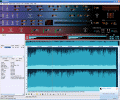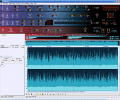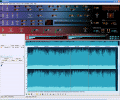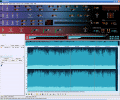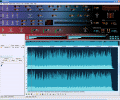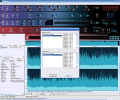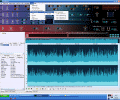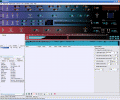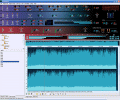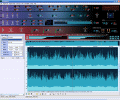Those who are interested in professional audio production already know about one of the industry's leading mastering tools, the iZotope Ozone. Well, Valvemaster comes as a serious competitor and the battle will be, if it isn't already, fierce. While Ozone brought forward the high-tech, Valvemaster comes with the tube-tech.
Still, I suppose it is a bit early to say who's going to win and it rather seems that peoples' affinities, likes and dislikes will balance everything. I can't tell so far which is best because I happened to work in a studio only with Ozone. But during the last hours I've messed with Valvemaster and I must admit I am very, very impressed.
The Looks
At a first glance, Valvemaster looks a bit complicated. And it actually is! Not that kind of complicated you might think of...I mean Valvemaster isn't at all the type of software in front of which you feel "small and helpless". But, to be more specific, the looks of the Valvemaster made me feel the need to be very careful: it looks the same as the old-style racks, the same racks that we, the pro musicians, either carry where sound reinforcement is needed or work on in studios.
Indeed, the Valvemaster's main controls consist of a 5 piece 1 RU (Rack Unit) set-up. Technically almost everything you might meet in a studio: A paragraphic EQ, a stereo imaging unit, a multiband dynamics module (aka compressor) and a valve preamp. A bit strange is the absence of the gate, the same as in Ozone. Not that in the mastering stage a gate could do much, it's just the fact that some days ago I had a discussion with a sound-man and he told me about how he had to further gate some recordings so his client was OK with the final product. Experimental or not, I just had to add this!
The Paragraphic Equalizer (as the other modules as well) looks almost as if it has just been taken out of his usual rack and brought inside my monitor. The producers of the Valvemaster went for the classic knob-type as found in real life only they added a digital-type counter beside each potentiometer so it looks really modern. Low and high cut knobs, 5 sweep-frequency bands, each with separate gains, an output level and a digital-looking EQ-sine preview complete the equalization module's looks.
The stereo Imager unit sports on-off switches besides the classic knobs and has L/R on-off options, a phase switcher, customizable highpass, center and side cut/boost pots, a "spatializer" switch and a spatial preview pane.
The Compressor looks exactly as other compressors do; it just has a knee-preview pane so the user has a better visual explanation of how the compressor has been set up. This unit also has a single/multiband switch and 2 split-frequency knobs for adjusting the multiband separation.
The next module is the Control Amp, virtually a tube/digital preamp loaded with some nice features like DSP Bypass, 2 bands-amping.
Last but not least, the Valvemaster has a very readable, highly efficient and very customizable VU-meter, for both pre-DSP and post-DSP signals. The best thing this meter bridge has is that it shows you much more info at the same time as I have seen so far in a bridge: peaks for the 2 channels, power and side/center levels so you know almost everything about your level at just one short glimpse.
The rest of the screen area is for the sine-view of the currently processed track and the general progress-view, right above the transport controls. The progress-view pane also shows the zoom level and lets you navigate on the entire track. In the left side of the screen are positioned the preset tools, the track-manager and other handy shortcuts to different tasks such as grouping various regions, searching and so on.
The Valvemaster has some nice color schemes; I liked best the blue default one, it seemed the closest to the "real thing" and the most eye-pleasing of all. Of course the user has the possibility to change technically every color inside the Valvemaster according to his own wishes; needless to say there are no skins.
The Works
It's very clear for me that I will test the Valvemaster on unmastered tracks so I can get the big picture on its limits and behavior. So far I put it at work on some finished material and I tried to get something different from this combination. I hope no one expects me to say I obtained a totally different sound; I began to discover, though, that the Valvemaster's Para-EQ is one hell of a tool.
Besides the low/high cut which allow you to set the audible range of your production, you have a multitude of choices as to where would your sound go: 5 frequency ranges at your choice, each with its own band and gain. From SubResonant to HiShelf, there is really an infinity of EQ settings you can apply. Everything in Valvemaster works in real time so there is no need to undo: it is all the same 50's classic way to "make sounds sound"...tweaking knobs, playing, hearing and tweaking again until all is set the way it should be.
The Stereo Imaging features a phase shifter which toggles between two totally different sound-types and balance between center and side signal also contributes to a better processing. Depending on what you want to get, very interesting effects can be obtained by combining the "spatializer" switch and those side/center buttons. The sound really widens and seems to change shape inside a "container"; it's just up to the "man at the knobs ".
The compression unit works beautifully; when the signal is high, you can effectively feel the incisive compression and limiting squashing the sound and guiding it on the right settings. The Valvemaster's compressor meter is a long one and seems pretty accurate. A nice thing here as well: it works on three generic frequencies: high, mid and low, thus allowing you to get better info on how the dynamics of a particular track work.
The amp section features a 2-type amp, digital and tube, each having almost the same characteristics as in the real life, meaning the tube sounds warmer and fatter and the digital one a bit more cutting. As I've said before, the Meter Bridges for both Pre and Post DSP show accurate and detailed info.
What does the Valvemaster have more than other mastering softwares is the capability to record and sample. Whether you sample or capture profiles from an already existing track or record a new one and capture DSP settings, the Valvemaster will do it. You can also record as if in a multitrack host except there's but one track here. Anyway, the sampling (or snapping, as it's called in the Valvemaster) is one good thing because you can more easily transport settings from one track to another.
From what I've seen so far, Valvemaster is one very serious tool which does serious jobs for professionally-sounding audio. I am looking forward to test further this piece of code in more "professional" situations and somehow I just know I won't be disappointed at all.
The Good
Up until now, all I have gotten to test worked perfectly. I fell in love with the awesome options and works of the Paragraphic EQ. In my humble opinion, this unit is the strongest point for Valvemaster. Along with the versatility of the amp, this software seems to be the next thing I'll "hunt".
The Bad
For those who just want to play, the Valvemaster may seem as an expensive toy. But to those committed to audio production it definitely isn't. Since all I worked with gave excellent results I won't say bad things about Valvemaster.
The Truth
One good mastering software than can surely output remarkable results when used wisely, whether you will make techno or heaviest of heavy metal. A "best-buy"-type program that's guaranteed to make your audio sound far better than the usual good amateur stuff.
Here are some snapshots of the application:
 14 DAY TRIAL //
14 DAY TRIAL // 